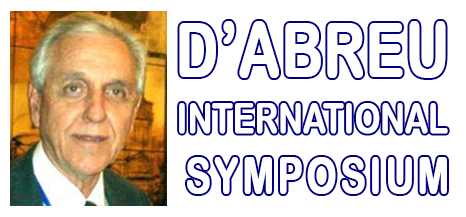List of Accepted Abstracts As of 14/12/2025: (Alphabetical Order)
Summit Plenaries
D'Abreu International Symposium (4th Intl. Symp. on Advanced Sustainable Iron and Steel Making)
Dubois International Symposium (Intl Sympo. on Sustainable Complex Metallic Systems)
Øye International Symposium (Intl Symp. on Sustainable Ionic Liquid and Aluminum Extraction and Processing)
Santilli International Symposium (Intl. Sympo. on Sustainable Mathematics Applications)
Starkey International Symposium (3rd Intl. Symp. on Sustainable Mineral Processing: Principles, Technologies and Industrial Practice)
Yagi International Symposium (2nd Intl. Symp. on Sustainable Metals & Alloys Processing)
Yang International Symposium (3rd Intl. symp. on Multiscale Material Mechanics and Multiphysics and Sustainable Applications)
2nd Intl. Symp. on Advanced Materials and Technologies for
Sustainable Energy and the Environment(AMTSEE)
2nd Intl. Symp. on Multifunctional and Smart Materials, Systems and Structures for Sustainability (MSMSSS)
3rd Intl. Symp. on Sustainable Secondary Battery Manufacturing and Recycling
3rd Intl. Symp. on Sustainable Base-metal Bio-extraction
3rd Intl. Symp. on Sustainable Cement Production
Intl. Symp. World Forum on Sustainable Coal Combustion and Processing
3rd Intl. Symp. on Sustainable Surface and Interface Engineering: Coatings for Extreme Environments
4th Intl. Symp. on Composite, Ceramic and Nano Materials Processing, Characterization and Applications
3rd Intl. Symp. on Sustainable Energy Production: Gas/Oil/Shale; Coal; Nuclear; Waste/Bioprocessing and renewables: wind/waves
5th Intl. Symp. on Environmental, Health, Policy, Legal, Management and Social Issues Related to Metals, Materials and Mineral Processing
3rd Intl. Symp. on Sustainable Production of Ferro-alloys
3rd Intl. Symp. on Sustainable Mining Operations
4th Intl. Symp. on Sustainable Molten Salt and Ionic Liquid Processing
3rd Intl. Symp. on Synthesis and Properties of Nanomaterials for Future Energy Demands
4th Intl. Symp. on Sustainable Non-ferrous Smelting and Hydro/Electrochemical Processing
2nd Intl. Symp. on Physics of Surfaces and Interfaces, from Fundamentals to
Sustainable Applications
4th Intl. Symp. on Quasi-crystals, Metallic Alloys, Composites, Ceramics and Nano Materials
3rd Intl. Symp. on Rare Earth and Platinum Group Metals: Managing and Processing
4th Intl. Symp. on Sustainable Materials Recycling Processes and Products
Intl. Symp. on Rotary Kiln Operations for Sustainable Products
4TH INTL. SYMP. ON COMPOSITE, CERAMIC AND NANO MATERIALS PROCESSING, CHARACTERIZATION AND APPLICATIONS
Effect of inhomogeneous composition on the superconducting properties of practical superconductor
Y.
Li1 ;G.
Kang2 ;
1SOUTHWEST JIAOTONG UNIVERSITY, Chengdu, China; 2APPLIED MECHANICS AND STRUCTURE SAFETY KEY LABORATORY OF SICHUAN PROVINCE, SCHOOL OF MECHANICS AND ENGINEERING, SOUTHWEST JIAOTONG UNIVERSITY, Chengdu, China;
Type of Paper: Regular
Id Paper: 266
Topic: 18We extend the Ginzburg-Landau-Abrikosov-Gor¡¯kov (GLAG) theory to account for the variation of the upper critical field with tin composition content in practical superconductor Nb3Sn. The upper critical field near the critical temperature is then extrapolated to that at temperature 0K, coinciding with the experiment results. Applying the theoretical formulas in technical Nb3Sn wires, we obtain the dependence of the composition gradient on the superconducting properties variation in the A15 layer. This explains the discrepancy induced by the inhomogeneous composition between the state-of-art scaling law results and the experiments. Keywords: Composites; Electrical; Materials; Metal; Microstructure;
Functionalization of carbon nanomaterials and their application in H2 gas sensor
S.
Dhall1 ;
1NIT, KURUKSHETRA, Kurukshetra, India;
Type of Paper: Regular
Id Paper: 350
Topic: 18Carbon materials that include diamond, graphite, graphene, carbon nanotubes (CNTs), among them CNTs
have received considerable attention from many researchers due to their extraordinary mechanical,
electrical, and thermal properties. These excellent properties provide thrilling opportunities to fabricate new
materials for advanced applications. Owing to their outstanding properties, scientists are interested to
investigate and modify these new substance classes. However, they are available in the form of fluffy powder,
which is difficult to handle. In addition, as grown carbon materials contain a large amount of impurities such
as growth metal catalyst (Fe, Ni, and Cu), particle soot, and amorphous carbon as a synthetic
residue. The well homogeneous dispersion of these materials into the host media, which can be in the form
of liquid or solid materials, is one of the major challenges encountered in the fabrication of nanocomposite
and devices used in nanoelectronic and interconnected technologies. Also, these materials are chemically
inert and have poor solubility in solvents as well as in water because of the strong carbon –carbon
interaction and van der Waals’ attractions between them. This limitation often requires controlled chemical modification/functionalization of these materials on the surface of the carbon materials in order to improve their solubility and dispersion stability in the solvent including water. Chemical functionalization has
been simply dispersed and solubilizes these carbon materials, by attaching hydrophilic species to their hydrophobic structures. In spite of this, functionalization process removes impurities like amorphous/carbonaceous carbon and dissolution of the metal catalyst although aggressive functionalization of
carbon materials shortens its length and destructs their structure, which strongly affect the electrical properties. These functionalized materials are proving to be valuable in a broad range of areas starting from the preparation of nanocomposites to the fabrication of sensors, solar cell and lithium ion battery. Keywords: Nanocomposites; Nanotubes;
Research of Producing Special-Purpose Composite Products by SHS – Electric Rolling
A.
Tutberidze1 ;T.
Namicheishvili2 ;G.
Tavadze1 ;G.
Oniashvil3 ;Z.
Melashvili4 ;Z.
Aslamazasvili4 ;G.
Zakharov5 ;
1FERDINAND TAVADZE INSTITUTE OF METALLURGY AND MATERIALS SCIENCE, Tbilisi, Georgia; 21FERDINAND TAVADZE INSTITUTE OF METALLURGY AND MATERIAL SCIENCE, TBILISI, GEORGIA, Tbilisi, Georgia; 31FERDINAND TAVADZE INSTITUTE OF METALLURGY AND MATERIAL SCIENCE, TBILISI, GEORGIA., Tbilisi, Georgia; 41FERDINAND TAVADZE INSTITUTE OF METALLURGY AND MATERIAL SCIENCE, Tbilisi, Georgia; 5FERDINAND TAVADZE INSTITUTE OF METALLURGY AND MATERIAL SCIENCE, Tbilisi, Georgia;
Type of Paper: Regular
Id Paper: 359
Topic: 18Metal-ceramic composite materials due to their physico-mechanical properties have a wide spectrum of application (space, aircraft engineering, chemistry, agriculture, machine-building industry). Georgia has less experience in the above mentioned materials and producing products from these materials. Hence working up the technology of producing and implementing metal-ceramic composites and proper products from them is an actual problem. <br />Among numerous ways of producing metal-ceramic composite materials, especially important is Self-Propagating High-Temperature Synthesis (SHS) accompanied with pressure shaping because of energy saving, cheapness, effective control of the process and the possibility of giving the planned properties to the materials. However this process has strictly specified technological parameters, SHS process is going fast and so the existed technologies (pressing, extrusion) of pressure shaping (SHS) provide producing only finite sized piece products. <br />The combined process of SHS and rolling cannot provide the continuity of synthesis either, as the process is terminating because of intensive thermal losses in the deformation zone. <br />By combining SHS and electric rolling processes it is practically possible to produce products of any length. For this purpose, an innovative technological process of producing composite materials has been developed in the institute. It is based on the combination of Self-Propagating High Temperature Synthesis and electric rolling. On a specially constructed laboratory electric-contact rolling mill by passing the heating current through the deformation zone synthesis is initiated. By synchronization of the speeds of the burning front displacement and of rolling and compensation of thermal losses in the deformation zone continuous rolling of the hot mass is carried out. <br />There is a perspective of continuing the started work. After certain theoretical research and working up the suitable technology, which in present conditions is considerably simplified, it is possible to produce not only plates, but multiprofile and multifunctional products as well. Keywords: Ceramic; Composites; Optimization;
[Boron-related materials, preparation, structure and application]
Study on nano TiB2 coatings deposited by CVD
X.
Huang1 ;S.
Sun1 ;S.
Lu1 ;X.
Zhu1 ;
1NORTHEASTERN UNIVERSITY, Shenyang, China;
Type of Paper: Regular
Id Paper: 411
Topic: 18The coatings of titanium dibordie (TiB2) on a high purity graphite substrate by chemical vapor deposition (CVD) were studied in this paper. The TiB2 was synthesized by using a gas mixture of TiCl4, BCl3 and H2. The properties and microstructure of TiB2 coatings were investigated by changing the factor of gas flow ratio of TiCl4 / BCl3. It was revealed that the grain sizes of TiB2 coatings were about 10-80 nm, which determined by X-ray diffraction, field emission scanning electron microscopy and transmission electron microscope. The analyzed results also illustrated that the grain size increased with the increasing of the gas flow ratio of TiCl4 / BCl3. Furthermore, the coatings grow faster, the grain size of TiB2 become large, the crystal plane of (001) and (110) develop slowly. The micro hardness of TiB2 coatings is different when the gas flow ratio of TiCl4 / BCl3 is changing. The more gas flow ratio is, the higher micro hardness is. Keywords: Ceramic; Coatings; Nanoshells;
The Large Scale Synthesis of Aligned Plate Nanostructures
P.
Nash1 ;Y.
Zhou2 ;
1IIT, Chicago, United States; 2ILLINOIS INSTITUTE OF TECHNOLOGY, CHICAGO, United States;
Type of Paper: Plenary
Id Paper: 182
Topic: 18Nanostructured materials have great potential in a large number of applications that can benefit society. Many applications such as catalysis and filtering take advantage of the high surface area and porosity that can result from nanostructures. The current issue for the synthesis of nanoscale materials often involves the use of chemical techniques that are inefficient and difficult to scale up. In many cases synthesis techniques are simply too slow to apply to a large-scale manufacturer. It is, therefore, beneficial to develop synthesis techniques to produce self-assembled, self-supported nanostructures on a large scale.
This work is directed at addressing issues of self-assembly, structural alignment and scalability for the production of nanoscale plates through a novel synthesis technique.
The synthesis technique is demonstrated using the discontinuous precipitation of a γ’ phase, (Ni, Co)3Al, followed by selective dissolution of the γ matrix phase. The production of the nanostructure requires heat treatments of the order of minutes and can be performed on a large scale making this synthesis technique of great economic potential. The resulting structure may have many applications in catalysis, filtering and heat management depending on the phase selection and added functionality through a chemical reaction with the retained phase. Keywords: Microstructure; Nanotechnology; Processing; Synthesis;
« Back To Technical Program
|



